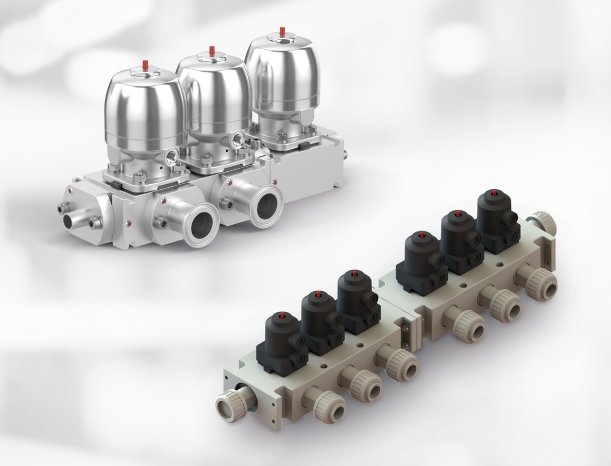In addition to multi-port valve blocks manufactured on a case by case basis, today modular and partly standardized block systems made of plastic or stainless steel are already in use in many sectors. Thanks to the systematic construction of the modules, complex valve assemblies can be paired in a variable way based on fewer basic bodies, meaning complex actuator travel and flow paths can be produced with different layouts of basic bodies.
The new, innovative GEMÜ P600S M-block solution now goes one step further, facilitating later modification to connections via a flexible connection system, so that different types can be integrated individually into the respective processes.
The modular basic bodies and connections can be kept in stock as single components and paired depending on requirements on a case by case basis. GEMÜ thus provides plant engineers and operators with the option of flexibly adapting or expanding their process plants at any time directly on location.
GEMÜ P600S is available in various plastics as well as stainless steels.
GEMÜ P600S made of plastic for chemically corrosive media
With the plastic series of the new GEMÜ P600S, GEMÜ provides a multi-functional solution for blending, diverting, draining or feeding chemically corrosive media. The modular M-block diaphragm valve is available in materials PP-H and PVC, and in nominal sizes DN 8 to DN 25. Spigots, threaded sockets and union ends on the basic body can be adapted to individual requirements via the flexible connection system.
GEMÜ P600S in stainless steel for aseptic applications
With the stainless steel series of the new GEMÜ P600S, GEMÜ provides a multi-functional solution for blending, diverting, draining or feeding demanding media in the pharmaceutical industry, biotechnology industry and the food industry. The modular M-block diaphragm valve is available in various stainless steel materials, and in nominal sizes DN 20 to DN 25 – other versions are available on request. Spigots, flanges and clamps on the basic body can be adapted to individual requirements via the flexible connection system. The interfaces for individual components have been designed based on a standardized aseptic connection.


